Text
Ganapati - Once and Future Leader
In which Harsha Prabhu follows in the footsteps of the Elephant-headed God and bumps into some inconvenient truths
"Vakratunda Mahakaaya, Suryakoti Samaprabha Nirvighnam Kuru Mey Deva, Sarva Kaaryeshu Sarvada"
Ganesh Mantra
(The lord with the curved trunk and a mighty body, with the luster of a million suns I pray to thee, to remove all obstacles from my path)
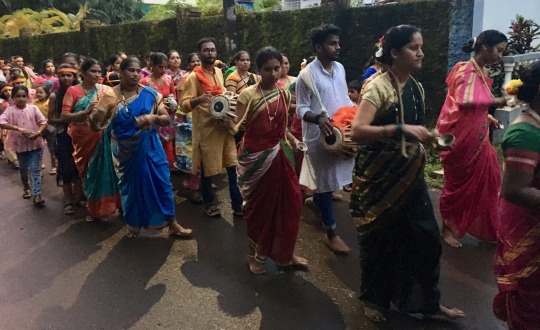
Ganapati procession, Arambol, Goa, September 2019. Pic: Harsha Prabhu
Arambol, Goa September 2019
Bhajan Mandali
Ganapati, aka Ganesh, the elephant-headed god, has many devotees among the Hindu community in India. Many Hindu households install an image of the god and offer prayers, conduct rituals and invite their neighbours for a darshan (viewing) of the god and share lunch or at least prasad (ritual offerings) together.
In the evenings, groups of musicians (mandali) go from house to house and sing bhajans (devotional songs) in his honour.
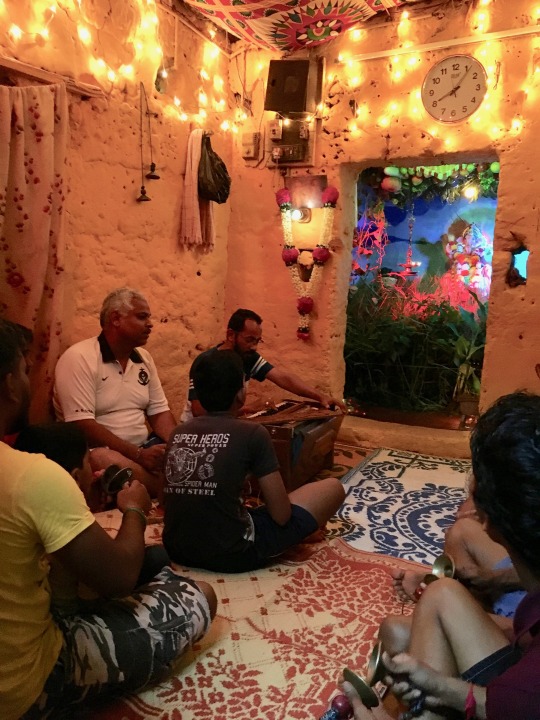
Bhajan mandali at a house in Arambol. Pic: Harsha Prabhu
One night in Arambol, I visited five households with a bhajan mandali. Apart from hymns to Ganapati there were many abhangas (songs) composed by Tukaram, the Marathi Bhakti poet-saint, beloved of the people.
The singing sessions were robust; the tea, coffee, fruit and snacks provided by every household plentiful. In one house we went to, the owner locked the doors to ensure that we finished all the food and drink he had to offer. What with the round of lunches and snacks, my midriff began to resemble the ample girth of Ganapati.
After a set number of days - anywhere between two and twenty one - these Ganapati idols are immersed (visarjan) in the sea or any available waterbody.
Sarvajanik Ganapati
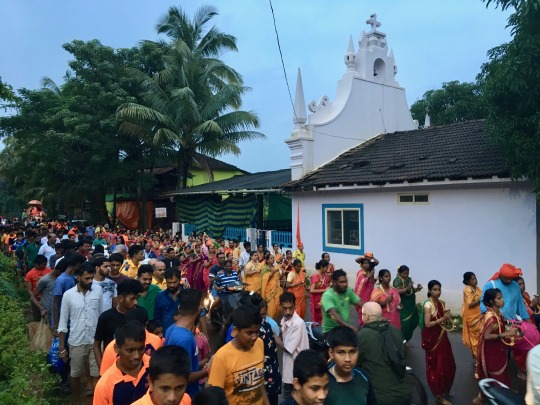
Ganapati procession, Arambol. Pic: Harsha Prabhu
Besides these household Ganapatis, there’s also the Sarvajanik Ganpati, a ‘people’s Ganapati,’ that is set up in a public place for the community to worship.
Last Thursday this Sarvajanik Ganapati - which was on show at a public hall in the village - was set atop a pick up truck and wound his way through the main street of Arambol to the sea shore. He was accompanied by singing and dancing women - resplendent in their traditional, nine-yard sarees, nose rings and other accoutrements - and children and men playing drums. Along the way groups of young boys lit firecrackers.
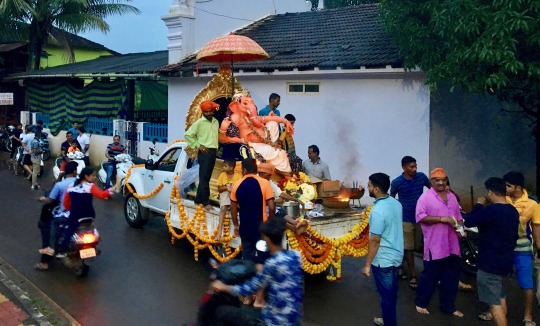
Ganapati procession, Arambol. Pic: Harsha Prabhu
To escape breathing the fumes from the firecrackers and the loud explosions they made, I made my way down to the beach. The sun was about to set; the tide was coming in.

Ganapati procession, Arambol. Pic: Harsha Prabhu
Soon groups of women descended on the beach. These were the singers and dancers from the street parade. I began to notice what sounded like a low murmur enveloping the beach. At first I couldn’t work out where the sound was coming from. Then I realised it was coming from the gathered women. They must have all been whispering prayers under their breath. It sounded like the humming of bees.

Ganapati procession, Arambol. Pic: Harsha Prabhu
Then the truck with the Ganapati appeared and manoeuvred on the sand. More prayers, more dancing by the women and drumming by the men. Fireworks lit the now-dark sky.
A simple prayer was read out in Marathi, expressing the humble hopes of the people: As in past years we have been worshiping you. Please forgive us for any misdemeanors on our part. Please help children gain knowledge through education. Please also help all people get jobs and become healthy and wealthy. Please bless everybody.

Ganapati visarjan, Arambol. Pic: Harsha Prabhu
Then, with shouts of “ Ganpati Bappa Morya, pudhcha varshi loukar ya” (Hail Father Ganapati, come back soon next year), a bunch of men lifted the idol from the truck and walked him into the sea. The incoming tide pushed the watching worshipers to higher ground. Thus ended this year’s Ganapati celebrations in Arambol.

Ganapati visarjan, Arambol. Pic: Harsha Prabhu
Leaving the beach, I heard one young man tell his friend: “Ganapati has gone. Now we can eat fish.”
This was a reference to the fact that, for the period of Ganapati’s stay in the village, Goa’s Hindus refrain from eating fish or meat of any sort, or even eggs - a big sacrifice for people for whom fish is a dietary staple.
I thought to myself: Goa’s fish better watch out.

Ganapati visarjan, Arambol. Pic: Harsha Prabhu
Ganapati - a potted history
I am indebted to the work of Debiprasad Chattopadhyaya, Marxist philosopher and historian, for much of what follows. Errors in interpretation are my own.
In his landmark book, Lokayata: A Study in Ancient Indian Materialism, Chattopadhyaya uncovers the tangled web of the Ganapati story, following its twists and turns, marking the vicissitudes of the rise and fall and subsequent rise of Ganapati.
Ganapati means leader/father (pati) of the tribe or group (gana) in Sanskrit.
Clearly, Ganapati is very old, a totemic figure from India’s tribal past.

Ganapati visarjan, Arambol. Pic: Harsha Prabhu
Ganapati is mentioned in the Rig Veda (1200 - 900 BCE) as "the seer among the seers, abounding beyond measure in food, presiding among the elders and being the lord of invocation.”
In the Rig Veda, however, Ganapati refers to a person and there are many Ganapatis, described as leaders of different groups or tribes. “Ganesvaras, or Ganapatis, and Vinayakas are here represented as…many in number and present everywhere” (Bhandarkar). What’s more, the Rig Vedic Ganapati has not yet received his iconic elephant head.
Sakti Ganapati
Chattopadhyaya suggests that Ganapati is associated with the early agricultural tribal society that predates the time of the Vedas. He connects it with fertility rituals to do with mother goddess worshiping cultures.
Chattopadhyaya mentions how In some parts of India, Ganapati-worship is followed by the worship of Gauri, the mother goddess, and is connected with rituals to do with the new moon and the sowing cycle, where the goddess is depicted as “a bundle of plants, along with her human representative - a virgin.”
(I saw a remnant of this in Goa. Just before my neighbour’s household Ganapati was whisked away by the men to be immersed in the sea, the matriarch of the house ran out of the house with a sheaf of plants and blessed the idol, saying “Gauri, Gauri.”)
According to Chattopadhyaya, Ganapati is also a key figure in Tantric rituals. There are 50 different names for Ganapati in Tantric literature; and some of the followers of Ganapati (e.g. Ucchista Ganapati) were also ‘vamacaris’, ‘tantrics,’ who practiced ritual group sex.
There are also female versions of Ganapati, know as Vinayaki, shown with the head of an elephant and the body of a youthful woman (Silparatna, 16th century). These too may have Tantric origins. Similarly, the Buddhist Hevajra Tantra mentions an elephant-headed goddess, Ganaptihrdya.
Then there are the Sakti Ganapatis, where Ganapati is shown embracing a female, where the male god is depicted as being subordinate to the goddess. Chattopadhyaya points to the idol in the famous Ellora caves, where Ganesa is “subservient to the seven women, called the seven mothers (sapta matrikas).”

Ganapati procession, Arambol. Pic: Harsha Prabhu
Ganapati as trouble-maker
The patriarchal backlash was predictable.
Perhaps because of this heterodox, tribal, matriarchal and Tantric connection, in the Griha Sutras (500 BCE), commentaries on the Vedas, we find Ganapati inspires dread: a follower of Ganapati “…sees in dreams waters, men with shaved heads, camels, pigs, asses…”
The Upanishadic Brahmin sage Yajnavalkya (8th-7th century BCE) saw Ganapati in the same vein: “Being possessed of Ganapati, the Princes Royal do not obtain the kingdom.”
Chattopadhyaya’s masterly analysis - combining comparative history and anthropology - shows the Ganapati story to run parallel to the destruction of tribal society in India and the rise of monarchies and centralised state power, buttressed by the panegyrics of patriarchal Brahminism as an ideological force providing the social glue to cement the status quo, including caste discrimination.
No doubt that’s why the Manusmriti, the Lawbook of Manu (2nd century BCE - 3rd century CE), a Brahmanical text, looks down upon Ganapati. Says Chattopadhyaya: ’A couplet ascribed to him (Manu) describes Ganapati as the deity of the depressed classes, the Sudra, and this in clear contrast to Sambhu, the deity of the Brahmanas, and Madhava, the deity of the Ksatriyas.’
Indeed, many of the names of Ganapati - Vignakrit, Vignaraja, Vigneshwara - suggest this adverse history. ‘Vigna’ means ‘trouble’ in Sanskrit.
Trouble-maker Transformed
How did the Vignakrit, ‘trouble-maker’, become today’s remover of trouble?
The transformation of a radical force into its opposite is a tribute to the powers of co-option exercised by the ruling classes in all societies, but is a special hallmark of Indian culture. It’s always the winners in the culture wars that shape the narrative, that write the history books.
One way of doing this is to make room for this radical figure of popular appeal - originally a person, then a totem, now a god - and include him in the premier pantheon of the gods. Again, Indians are masters of this kind of mystification and cultural assimilation.
Thus, a whole back-story is created for Ganapati, including how he got his elephant’s head, and a new lineage, wherein he becomes the child of Shiv and Parvati, and is admitted into the mainstream Hindu canon of worship.
It’s a classic tale of the absent father, Shiva, who does not recognise his son, Ganapati, who is guarding his mother, Parvati, while she bathes. The father beheads his son; but then relents on discovering his true identity and crowns him with the head of an elephant. It’s your typical Oedipal story, but with a happy ending, worthy of Bollywood.
Far from seeing him as a trouble-maker, the medieval Puranas - especially Skanda Purana, Narada Purana and the Brahma Vaivarta Purana - are full of hyms praising Ganapati.
Chattopadhyaya, quoting A K Coomaraswamy, tells us the elephant-headed version of Ganapati that we are familiar with appears around the time of the Guptas, in 5th century CE. Before this, Ganapati is shown with other heads, including bull and snake heads, again betraying his tribal, totemic origins.
Inconvenient Truth
Still, some inconvenient truths remain to be explained.
One of the names of Ganapati is Ekadanta, ‘one-tusked’, and he is depicted thus in art and iconography. How did Ganapati come to lose one tusk?
The Brahma Vaivarta Purana says he lost his tusk in a battle with Parshurama, the Brahmin who was also a warrior. If nothing else, this suggests a struggle between Ganapati, the leader of the common people, and the aggressive Brahmin proselytisers.
Interestingly, this same Parshurama is credited with the creation of Goa. In the Sahyadri Khand of Skandha Purana, he is said to have shot an arrow at the sea god and caused the whole Konkan coast - of which Goa is a part - to be created. Here we have a thinly disguised tale of the Brahmin colonisation of South India, presented as a creation myth.
Tilak’s Dream & Hindutva
Ganapati worship in its current, public form was the brainchild of Bal Gangadhar Tilak, social reformer and nationalist, and dates from the 1890s.
Tilak observed the popularity of Ganapati among the masses in Bombay and sought to propagate it in a public manner - the Sarvajanik Ganapati - as a strategy to both subvert the British ban on people gathering in public spaces post the Indian Mutiny and as a tactic to ‘bridge "the gap between Brahmins and non-Brahmins", thereby building a grassroots unity across them to oppose British colonial rule’ (wiki).
130 years down the track - and 72 years since India won independence from the British - while the public celebration and worship of Ganapati has grown in leaps and bounds across many states in India, so has the gap between ‘Brahmins and non-Brahmins,’ which has now become a chasm, with caste-based atrocities, including lynchings of Dalits - the Sudras of the Manusmriti - on the rise in India.
Dalits are beaten up for merely growing a moustache, or riding a horse to a wedding, or participating in a dance - all activities only permitted to the upper castes. Dalits also frequently die from asphyxiation while manually cleaning sewers - which caste-obsessed India still permits in the 21st century, as a job reserved for Dalits alone.
Tilak’s dream of unity among Hindus has been zealously taken up by the Hindu Right under the leadership of the RSS and its political face, the BJP government of Narendra Modi, with the avowed aim of turning India into a Hindu nation.
Here, unlike in Tilak’s time, the enemy is not the British, but secular India.
Apart from discriminating against India’s many minority communities and tribal population, this Hindutva project is a false unity, as it’s a unity under the hegemony of the Brahmins and the upper castes, as any persecuted Dalit would know. Despite the co-option of a Dalit as the President of India.
And while Dalits continue to be an underclass, tribal India, from which matrix Ganapati originated, doesn’t even figure in the national discourse, except as a shadowy victim on the margins of a rapacious state bent on depriving tribals of their forests and livelihoods via resource exploitation and displacement caused by big dams and mining.
Echoes of the Tribal Past
D D Kosambi, Marxist historian and polymath, says: “The entire course of Indian history shows tribal elements fused into a general society. This phenomenon, which lies at the very foundation of the most striking Indian social feature, namely caste, is also the great basic fact of ancient Indian history.”
What accounts for the persistence of an ancient totemic figure like Ganapati in 21st century India?
Chattopadhyaya offers a classic Marxist analysis and points to the ‘uneven development’ of Indian society. “This feature of uneven development remains a characteristic of Indian history throughout the successive ages, down to the very modern times.”
In other words, slums coexist with smart cities, as anyone who knows India will testify.
And what is true of the social and economic life, is also reflected in people’s ideology, including religion and rituals. Superstition coexists with space travel.
Indeed, the ancient and the modern jostle for space in the Indian mind today.
While tribes decay into castes and then morph into classes in a modern context, somewhere in their hearts and minds India’s people retain echoes of the archaic, tribal past.
Meanwhile Ganapati - the father of the tribe who became a totem and then a god - still awaits his destiny as the once and future leader of the common people - and the remover of all obstacles in their path.
#ganapati#arambol#goa#totem#marxists#history#philosophy#photography#tribal#indian history#sakti#tantra
8 notes
·
View notes
Text
Krishna on the Beach
Harsha Prabhu wanders on a beach in Goa and stumbles upon the God of Love
Arambol, Goa, August 2019
The Photoshoot
It was the weekend of the global protest against the destruction and burning of the forests in the Amazon basin, aided and abetted by the Brazilian government.
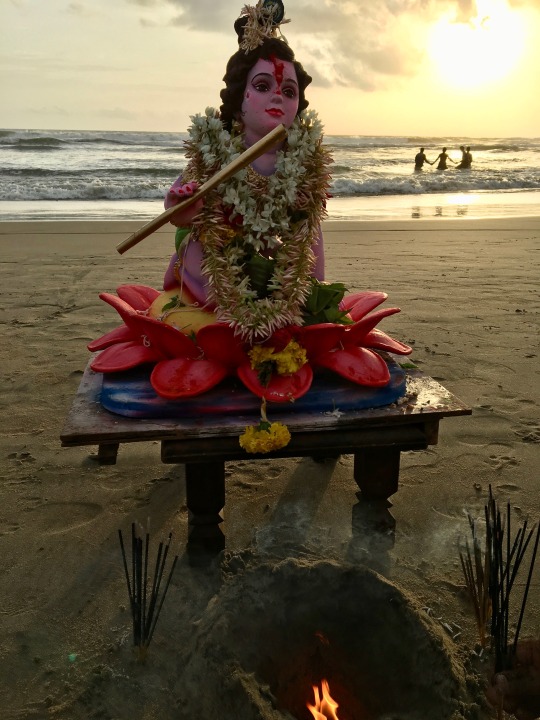
A few of us decided to hold a pop up demonstration at Arambol beach against this act of environmental vandalism that threatened the livelihood of the indigenous people of Brazil - and 20% of the world’s oxygen supply. The demo would be in the form of a photo shoot, with people holding placards that spelt: SOS Amazon! We needed a quorum of 12 people to hold the placards. Seemed easy enough.
But it wasn’t. It took us a full hour of hustling on the beach to get the magic 12. Many we asked begged off for one reason or another: they did not understand what I said (Russian tourists); they were waiting for someone; they had to be somewhere else; they had to discuss it with their group before agreeing to participate. Some of these procrastinators were clearly entitled, middle class Indian tourists from major metros, visiting Goa as part of a package tour, sporting t-shirts with the tour logo. Somehow, we managed to find 12 souls willing and able to be a part of the the visual petition against the Amazon destruction.

After the photoshoot I wandered along the beach. Then I heard the sound of bells. Turning, I saw a group of men striding down the beach. One of them was carrying something on his head; the others were playing zills and chanting “Radhe Krishna ki jai!” (Hail Radha and Krishna).
The man who was carrying an idol of Krishna - Bal Krishna, Krishna as a child - placed it on the beach. His companions dug holes in the sand and placed incense sticks, to light which they borrowed my lighter. Slowly, people gathered around the idol; bits of camphor were burnt as offerings; prayers offered.
There was a large group of young boys who were playing in the sand nearby. Ever the opportunist for a photo grab, I went up to them and, addressing the biggest boy, asked: “Have you heard of the burning of the forests in the Amazon in Brazil?” “Yes” , he replied “ I saw it on the news.” “Would you like to help us stop it?” I asked him. “How?” he asked. “Simple. Just join with your friends in holding these placards,” I replied, “ I’ll take a photo and send it to the Brazilian government.”
“Yes, yes,” he shouted and turned to explain to the rest of his friends what was proposed. Before I could say ‘Krishna’ I had 12 eager and willing young participants in the photoshoot. In an attempt to get them all in the frame I almost stumbled onto the Bal Krishna image on the sand.
Krishna Lila
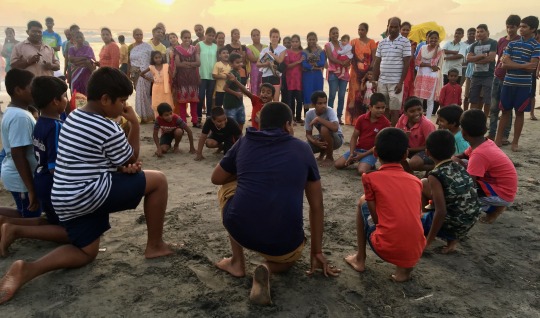
It was only then that I realised the young boys where part of a group that had come to participate in the Krishna ritual on the beach. In my mind’s eye, I saw them as the gopas (cow-herders) of Vrindavan, Krishna’s accomplices in his childish pranks, which, to the devotee, is an expression of the God’s ‘Lila,’, life as play.

And play they did, that evening on the beach, first the young boys, then the older youth and some men joining in. Games of tag, of skill and strength and guile. Then they attempted to smash the ‘Dahi Hundi’, the pot of yogurt - an object of mischievous fascination for Bal Krishna, called ‘Maakhan chor’, the butter-thief - held tantalizingly out of reach by a man wielding a rope and pully. Both groups of young boys and older youth managed to smash the Hundi, splattering themselves and those nearby with yogurt.
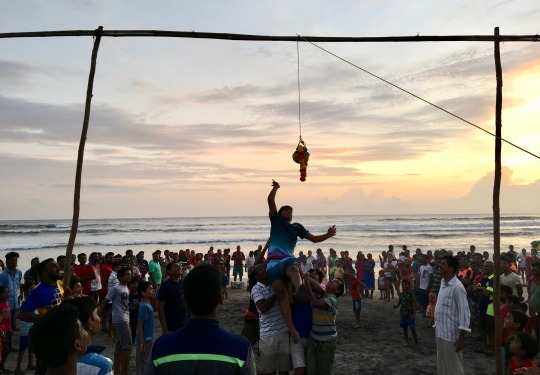
Where were the gopis (milk-maids) in all this play? Some stood by watching, like the ladies from Rajasthan, looking, with their aquiline features, nose rings and veils, like they had stepped out of a Kishangarh miniature, the 18th-century school of painting from Rājasthan, celebrating Krishna as a lover. Other gopis, possibly tourists from interstate or overseas, cavorted in the sea, holding hands in the water, playing their water games, framed by the setting sun.

Then it was time for more prayers and - as the sun set and the horizon turned maroon - time for the ‘Visarjan,’ the ritual immersion of the Krishna idols - the Bal Krishna being joined by a Krishna playing the flute - in the sea.
Who is Krishna?

Yesterday was Gokulashtami , the birthday of Krishna. Today is Visarjan. Who is Krishna, this God who was born yesterday and is committed to the waters the very next day?
Who is Krishna? This question bedevilled Arjun, the hero of the Mahabharata war, contemplating the field of battle. Is he my charioteer? My devoted friend and wise councillor? Or is he a God whose true face I dare not see?
There are many Krishnas; you can pick and choose.
There’s the culture hero of the Ahir, a tribe of pastoralists found in north and western India. The Ahirs are mentioned in the Mahabharata and some Ahir claim descent from the Yadava clan of Krishna.

There’s Bal Krishna, the baby Krishna, whose exploits form the material of songs mother’s sing to their children, whose devotion parallels the cult of baby Jesus.
There’s Krishna the lover, flirting shamelessly with the gopis of Vrindavan, all the while knowing his heart is with Radha, another man’s wife, in an erotic wheel-within-wheel of transgression, celebrated in much Indian song, dance and art.
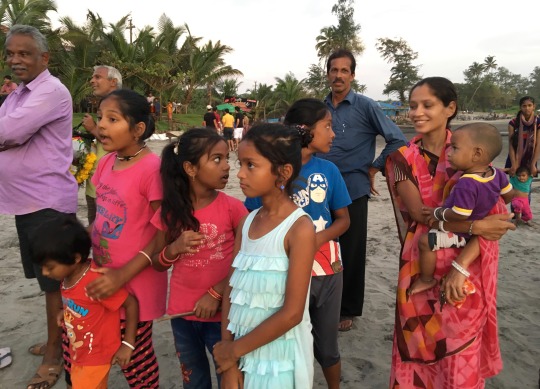
There’s the Krishna of the Bhagvad Gita, Arjun’s initiator into the terrifying mysteries of cosmic time, including the need to do one’s caste-defined, destiny-propelled duty, regardless of the consequences (nishkamakarma).
This was the Krishna that troubled M K Gandhi, possibly the greatest Vaishnav (Krishna devotee) of them all in recent times. The arguments in the Geeta rationalising violence, no doubt the work of Brahmins versed in the arts of sophistry in defence of the status quo, stuck in Gandhi’s throat. Gandhi would have agreed with D D Kosambi, polymath and Marxist historian, who said: ‘This slippery opportunism characterizes the whole book. Naturally, it is not surprising to find so many Gita lovers imbued therewith. Once it is admitted that material reality is gross illusion, the rest follows quite simply; the world of "doublethink" is the only one that matters.’
Bhakti
There’s the Krishna of the Bhakti saints, the social movement that was anti-caste, that talked up love for one’s fellow human as the highest goal.
The Bhakti saints came from all castes. Nammalvar was a peasant. Namdev was a tailor. Gora was a potter. Cokha Mela was Dalit. So was Ravidas, guru of Mirabai and contemporary of Guru Nanak. Jyaneshwar, who introduced the Gita to Marathi-speakers, committed ritual suicide. Tukaram, the greatest Marathi Bhakti poet of them all, was a peasant, who ran afoul of Brahmins, and is supposed to have drowned himself in the river Tungabhadra. There’s more than a hint that he was murdered by caste Hindus. Luckily, his abhangas (poems) survived…

What made Bhakti so radical?
Here is Chandidas, the 15th century Bengali poet:
"Shobar upor manush shotto tahar upore nai,” (“Above all is humanity, none else”).
Or Kabir, possibly the greatest of India’s many poet-saints, also from the 15th century, and a Muslim to boot, though not a practicing one by the looks of it. He wrote in the vernacular and, even to this day, his poems explode in the face, like existential firecrackers.
Saints I see the world is mad.
If I tell the truth they rush to beat me,
if I lie they trust me. — Kabir, Shabad 4, Translated by Linda Hess and Shukdeo Singh
Or this:
Saints I've seen both ways.
Hindus and Muslims don't want discipline, they want tasty food.
The Hindu keeps the eleventh-day fast, eating chestnuts and milk.
He curbs his grain but not his brain, and breaks his fast with meat.
The Turk [Muslim] prays daily, fasts once a year, and crows "God!, God!" like a cock.
What heaven is reserved for people who kill chickens in the dark?…
— Kabir, Śabda 10, Translated by Linda Hess and Shukdeo Singh
Or this one:
If God be within the mosque, then to whom does this world belong?
If Ram be within the image which you find upon your pilgrimage,
then who is there to know what happens without?…
— Kabir, III.2, Translated by Rabindranath Tagore and Evelyn Underhill
Interestingly, Kabir ran afoul of both Muslims and Hindus during his lifetime. It is said that, upon his death, both sets of believers fought over his corpse. When they lifted his shroud, all they found were flowers.
Knowing the pain of others
Here is Narsi Mehta, the 15th century Gujarat poet-saint, with a song that was a favourite of M K Gandhi:
Vaishnav jan to tene kahiye je/ Peed paraayi jaane re /Par-dukhkhe upkaar kare toye /Man abhimaan na aane re
Only he is a true Vaishnav Who knows the pain of others Does good to others without letting pride enter his mind.
Indian PM Modi also claims to love ‘Vaishnava jan to.’ He launched a version of the song in October 2018, sung by artists from 40 different countries, as the start of the year-long celebration of the 150th birth anniversary of Gandhi.
Does Modi know the pain of others?
This was his reply to a Reuters journalist in 2013, when asked what he felt about the communal carnage in Gujarat that lead to over a thousand deaths, mainly, but not only, Muslims, and the displacement of many more while he was CM in 2002: “If someone else is driving a car and we’re sitting behind, even then if a puppy comes under the wheel, will it be painful or not? Of course it is.”
Does Modi know the pain his policies, including demonetisation and high GST rates, have caused his people? The pain of all those who have lost their jobs due to an economy in shambles, largely due to the wreaking-ball of his government’s own policies? Does he know the pain of the farmers who commit suicide due to failing crops, drought and the inability to pay back loans? Or the pain of all the human rights defenders and tribals who languish in jail on trumped up charges? And what about the pain of the Kashmiri people?
What about the pain of Gandhians? The fact is that M K Gandhi himself was assassinated by a Hindu ring wing terrorist, a member of the Hindu Mahasabha, an off-shoot of the RSS, the very organisation that Modi belongs to.
What about the pain of all those people - mostly Muslim, Dalit or Christians - who have been lynched in India by mobs yelling “Jai Shree Ram”?
In July this year, eminent writers, filmmakers and intellectuals wrote an open letter to PM Modi, beseeching him to act, saying: "It is shocking that so much violence should be perpetrated in the name of religion! These are not the Middle Ages! The name of Ram is sacred to many in the majority community of India. As the highest Executive of this country, you must put a stop to the name of Ram being defiled in this manner.”
Modi has yet to respond to the letter.
Clearly, when it comes to knowing the pain of others, Modi has a lot of catching up to do.

Krishna the Redeemer
The Krishna story should make all tyrants everywhere worried.
For Krishna is also the redeemer. He comes to deliver the people of Dwarka from the rule of the evil tyrant Kamsa. Indeed, all tyrants dream of everlasting rule, but Kamsa himself hears a voice that tells him his end is near. This sets into play the whole Krishna myth, of the child abandoned by the palace, like Moses was among the bullrushes, a foundling fostered by another family, who grows up to avenge wrongs and claim his rightful throne.

According to Joseph Campbell: ‘The work of the incarnation is to refute by his presence the pretentious of the tyrant ogre.’
Further, Krishna, as the God of Love, refuses to allow himself to be weaponised by the armies of the Hindu Right, as opposed to the fate of poor Ram, where “Jai Shree Ram” has become a rallying cry of the lynch mobs.
Ironically, the actual form of greeting in parts of North India is “Jai Sia-Ram”; ‘Sia’ being a short form for ‘Sita’. But there’s no use for Sita, the Goddess of the Earth and Ram’s wife, in the hyper masculine world of Hindutva politics. The Goddess - and women - are the first casualties in Hindutva’s Raas Lila (sacred dance, dedicated to Radha-Krishna), where rape is a political tool to terrorise and subjugate people, sanctioned by V D Savarkar, the father of Hindutva ideology.
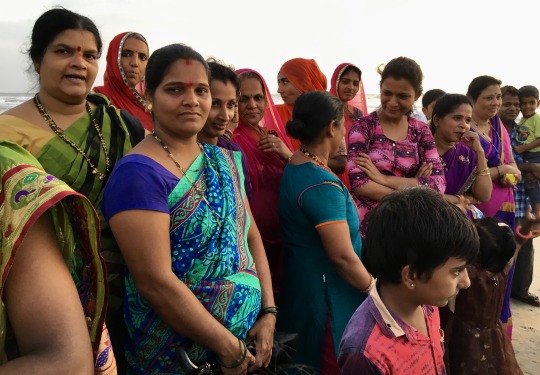
For Krishna devotees, Krishna is nothing without Radha; therefore it’s always “Jai Radhe-Krishna.” Behind Krishna stands the Mother Goddess. Vrindavan, the scene of the Krishna idyll, is the sacred grove (vana) of the Goddess Vrinda, another name for the Tulasi (holy basil) tree. To this day, the marriage of Krishna to Tulasi is celebrated every year in Vrindavan as Tulasi Vivaha. And even in Goa, for my landlord, Pritesh, was married to three Tulasi trees before he got a wife. Thus does the Great Mother break through Hinduism’s patriarchal bonds.

And it’s not just Hindus who worship Krishna.
According to literary critic Kuldeep Kumar, writing in The Hindu: ‘Many Muslim poets, the most notable among them being Raskhan, wrote devotional poetry to celebrate the Krishna legend and to rejoice in his bhakti. Abdur Rahim Khan-e-Khana, who is known in Hindi literature simply as Rahim, wrote many Barwais, Dohas and Sorthas in praise of Krishna. For example, this couplet is worth reading.
Jihi Rahim man aapno keenho chandra chakor Nisi baasar laago rahai Krishna chandra kee or (The way chakor always looks at the moon, similarly my face is always towards Krishna’s face that is as beautiful as the moon is). ‘ Chakor is a kind of partridge.

Passion Play
The passion play I witnessed on the beach was part of an ancient story, of the birth and sacrifice of a God. Like the Greek hero, Achilles, Krishna dies when an arrow pierces his heel, betraying his tribal, pagan origins. The culture hero dies, but the energies of an archetype never die, but live on, forever green in the hearts of men and women.

Surely Krishna - the hero with a hundred faces - will come to the aide of his people, wherever they may be, on a beach, in a temple, in the factories, on the land, in the forest, the vana, his favourite playground - or at the next political or environmental protest.
In a time of human-induced climate chaos and species extinction, driven by corporate fascism’s dystopian republic of greed, ruled by the global police state, the Radha- Krishna myth - of the world as a garden of plenty, as a playground for the divine erotic impulse to manifest, of love as the highest form of worship - is a very compelling counter-image.
Another world is possible. Krishna tells us it is.
While lovers of radical equality and seekers of bliss rejoice, tyrants everywhere better beware. Even as we speak, Krishna is on his way to Dwarka…
Pics: Harsha Prabhu
A note on the photoshoot:

Amazon photoshoot, Arambol, Sat 24 Aug 2019
SOS AMAZON! SOS CLIMATE EMERGENCY! Arambol, Goa, India Sat 24 August 2019
Members of Extinction Rebellion Goa staged a pop up demonstration at Arambol beach in solidarity with the native people of Brazil’s Amazon basin, whose forests are being burnt by the Brazilian government to facilitate development projects, including roads and big dams, in an ecologically sensitive bio region.
The burning forests of the Amazon are also a matter of grave concern as they supply 20% of the world’s oxygen. These forests are characterised as the lungs of the planet, taking in carbon dioxide and breathing out oxygen.
In addition, this wanton destruction feeds into the cycle of human-induced climate change. With the accelerated melting of the Greenland ice field via global warming predicted to raise sea levels by a frightening 25 feet, coastal communities like Goa are at special risk of being inundated by such irresponsible actions.
Activists also pointed out that India’s environmental record too was a scandal, with the continued destruction of forests, especially in the Western Ghats, leading to flooding in several states, including Goa, Maharashtra, Karnataka and Kerala. In Mumbai, the Aarey Forest in the centre of the city, also earmarked for development, and coastal mangrove destruction, are causing environmental stress on one of the world’s mega cities, also subject to periodic flooding.
India ranks among the bottom five countries on the Environmental Performance Index for 2018, according to a biennial report by Yale and Columbia Universities and the World Economic Forum. India also has the dubious distinction of overtaking China and Russia as the world’s top sulpha dioxide polluter, according to a Greenpeace report released on 19 August 2019. Sulpha dioxide is a by-product of coal-based electricity generation. Fossil fuels are also the key culprits in the global warming feedback loop and the proliferation of plastic pollution world-wide, including on Goa’s beaches.
With extreme weather events - like drought followed by floods in India - the norm, activists worldwide are calling upon governments to address the climate emergency, stop the reliance on fossil fuels and rapidly move towards adopting sustainable solutions to meet world energy needs.
The Brazil solidarity action - which included Arambol youth and local and international visitors - was part of a global weekend of similar demonstrations to put pressure on world governments to act now before it’s too late!
Pic: Harsha Prabhu, Design:Camelia Oberoi
#SOSAmazonia #SaveOurForests #ClimateEmergency #extinctionrebellion #extinctionrebellionindia #extinctionrebelliongoa #arambol #goa #DeclareClimateEmergency #SaveAareyForest #SaveWesternGhats
#sosamazon#krishna#radharani#lila#gokulashtami#gopi#gopa#bhakti#photography#goa#arambol#climate emergency#species extinction#extinctionrebellion
6 notes
·
View notes
Text
Celebrating the Woodstock 50th in Goa
In which Harsha Prabhu gets high on cake and a peace out!

Celebrating the Woodstock 50th anniversary, Guru Bar, Anjuna, Goa, 17 Aug 2019. Pic: Harsha Prabhu
Arambol, Goa, 17 Aug 2019
I’m woken from an afternoon kip washed by strange dreams of escape - from what is not clear - by knocking on the door.
It’s Pritesh, my landlord, with the cake he’s supposed to be surprising me with.
Somehow, the Redhead’s managed to alert ‘British’ (as she calls him) all the way from Kyogle in country NSW, Australia, that my birthday is coming up and that he should get me a cake - and this is the result.
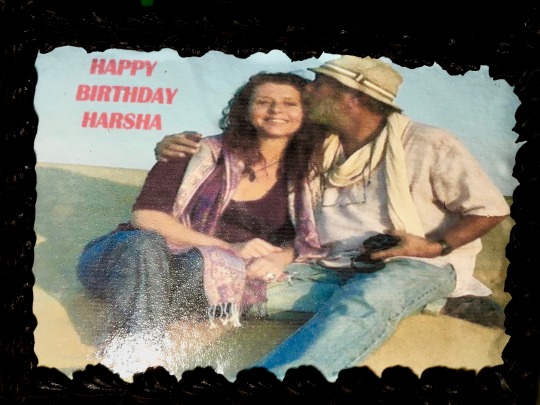
It’s a ‘Photo Cake’, made from Dutch truffle, veg, weight one kg, via a local branch of a bakery chain.
It’s got a pic of The Redhead and me, sitting on a sand dune, somewhere in the desert out of Jaisalmer in Rajasthan.
“I had to go through all her Facebook posts to find the right picture,” says Pritesh, with a note of stoic elation. He’s clearly proud of the cake. I’m gobsmacked by the icing, capturing a sweet snapshot in time.
I place the cake in the fridge and stagger back to bed to resume my interrupted kip - hoping, perhaps, to get a clue as to what I’m escaping from - when there’s another knock on the door.
“Pritesh, I’m trying to sleep,” I yell, but, when I get to the door, it’s Ajji (grandma), holding some steel containers in her hands: patal (wet) bhaji, cabbage upkari (dry curry) and boiled rice.
“Oh, I just had the gosale (a kind of gourd) curry and rice you gave me yesterday for lunch just now,” I say, in Konkani.
She gins at me, saying: “ I’m sure you can always eat some more.”
I remember the Redhead’s warning from earlier: They are trying to fatten you up for some reason. Watch out for that Ajji!
My midriff is clear testimony to the abject failure on my part to heed any such warnings, especially when it comes to Ajji’s cooking, which reminds me of my mother’s - coastal, Karwari, loaded with fresh, grated coconut.
Then the phone rings. It’s my cuz Mu, to wish me.
“Are you planning to send me some sapad (food) from Chennai?” I ask. “You can always do it via Zomato. I hear they’re reliable. And I don’t mind if the delivery executive is Muslim or Christian or whatever.”
“Always thinking of food, regardless of who’s delivering it,” says Mu, himself known as the Sapad King of Chennai.
There’s no point trying for that elusive kip. I decide to dive back into The Alexandria Quartet, by Lawrence Durrell, an old favourite. At over 800 pages, it’s my kind of book to read in the monsoons. A desert island bible, studded with jewels, like the sky at night after a storm.
Here’s just one; Justine on love: (”Damn the word” said Justine once. “I would like to spell it backwards as you say the Elizabethans did God. Call it evol and make it a part of ‘evolution’ or ‘revolt’. Never use the word to me.”)
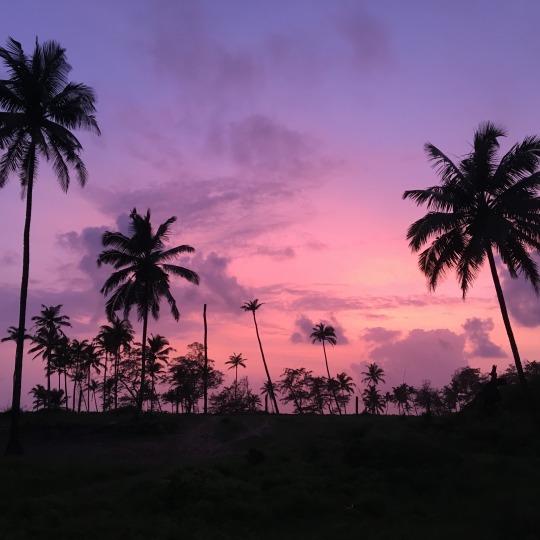
Pomegranet sky, Arambol Goa, Aug 2019. Pic: Harsha Prabhu
Sunset paints the sky pomegranet; palm trees like silhouetted sentinels; large birds - crows? - flying home to roost.
We divvy up the cake, sending a piece to all the close neighbours. If you read in the local papers about a section of the village of Arambol tripping on the sugary likeness of two desert nomads, you’ll know who’s responsible.
In the evening we make a beeline for Guru Bar in Anjuna to celebrate the Woodstock 50th anniversary.

Kittu Siqueira & Swapnil Naiak, organiser of the Woodstock celebration, Guru Bar, Anjuna, Goa, 17 Aug 2019. Pic: Pritesh Tari
Guru Bar itself was celebrating its 52 anniversary, a pointer to Anjuna and Goa’s nodal influence in the global hippie scene even before Woodstock happened in1969. Guru - fisherman and lifeguard of Anjuna - set it up as a beach shack, serving up his trademark veggie sandwiches and chai to the Goa hippie tribe, comfort food par excellence after a full moon all-nighter at Shiva Valley.
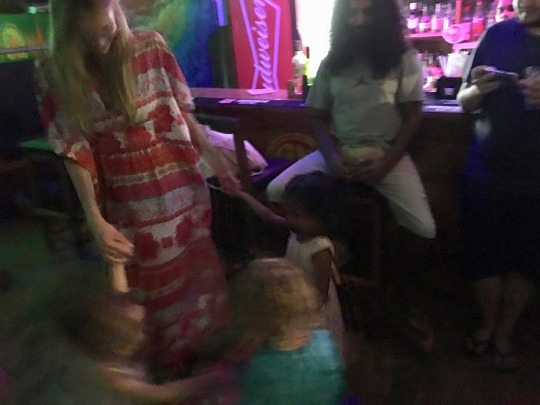
Celebrating the Woodstock 50th anniversary, Guru Bar, Anjuna, Goa, 17 Aug 2019. Pic:Harsha Prabhu
Now his sons, Swapnil and Satu, have continued the tradition by running it as a year-long live music venue, serving up a smorgasbord of young and established bands from everywhere. Swapnil has lined up a four-day music fest to celebrate Woodstock.

With Shailu, Celebrating the Woodstock 50th anniversary, Guru Bar, Anjuna, Goa, 17 Aug 2019. Pic:Harsha Prabhu
We’ve come hoping to catch Steve Siqueira and Kittu’s band. Kittu is an old connection. We grew up together in a complex of apartments in Colaba in South Bombay (as Mumbai was called in those days). Her father was Chic Chocolate - the legendary trumpet player and composer. She belongs to the first family of jazz in India. And Steve, her partner, has played in all kinds of bands up and down the land.

Steve Siqueira, Celebrating the Woodstock 50th anniversary, Guru Bar, Anjuna, Goa, 17 Aug 2019. Pic:Harsha Prabhu
I’m expecting to hear some cool jazz and soul, but, in honour of Woodstock, it’s only rock and roll - and I like it.

Kittu Siqueira, Celebrating the Woodstock 50th anniversary, Guru Bar, Anjuna, Goa, 17 Aug 2019. Pic:Harsha Prabhu
They rip through all the rock classics - the Who, Rolling Stones, The Doors - but also do a whole lot of numbers by Steely Dan, Steve’s keyboards creating an arabesque of almost jazzy soundscapes, matched by guitarist Nevin Dmello’s iiquid rock riffs.

Puja & Pritesh, Celebrating the Woodstock 50th anniversary, Guru Bar, Anjuna, Goa, 17 Aug 2019. Pic:Harsha Prabhu
At a break in the proceedings the second cake appears. This one, I find out later, is engineered by my sister, via a call to a friend in Mumbai, then one in Brisbane to get Kittu’s number, who naturally alerts Swapnil about my birthday. This one - a pineapple gateaux - is demolished in no time by everybody.
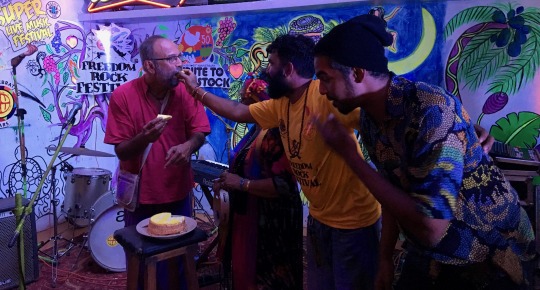
Celebrating the Woodstock 50th anniversary, Guru Bar, Anjuna, Goa, 17 Aug 2019. Pic:Pritesh Tari
Then Swapnil yells “Drinks on the house” and lays a bottle of Bacardi and a whole line of glasses on the bar and dishes up delectable rum cocktails to anyone who fancies one.

'Drinks on the house’, Guru Bar, Anjuna, Goa, 17 Aug 2019. Pic:Harsha Prabhu
I take advantage of the mayhem to smoke a peace pipe with Kittu and Steve. Steve mentions the passing of Peter Fonda, whose Easy Rider expressed the zeitgeist of those heady days of the sixties and seventies. It was also a prophetic film : its free-spirited anti-heroes, who hit the road in search of the American Dream - aided by, yes, drugs, dames, and possibly the best movie soundtrack ever, chockers with anthemic rock songs from those times - end up getting murdered by red necked gun-crazy folk. Much like what happened to the rest of the US, the land of the free.

Celebrating the Woodstock 50th anniversary, Guru Bar, Anjuna, Goa, 17 Aug 2019. Pic:Harsha Prabhu
Woodstock - whose 50th anniversary we were marking - was not just about the music, the drugs, the sex, for those who got lucky - though these did help.
It was also about peace, love and brown rice for all.
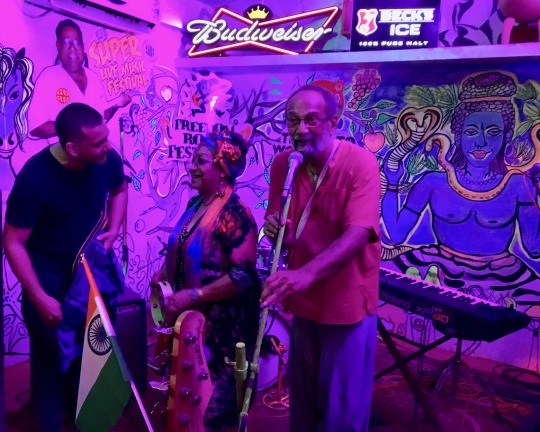
Celebrating the Woodstock 50th anniversary, Guru Bar, Anjuna, Goa, 17 Aug 2019. Pic:Pritesh Tari
It was also about a revolt against the system and a rallying cry for evolution towards a better world whose chords still resonate down the long years.
Especially in these lean times when peace, love - and rice - are in short supply.
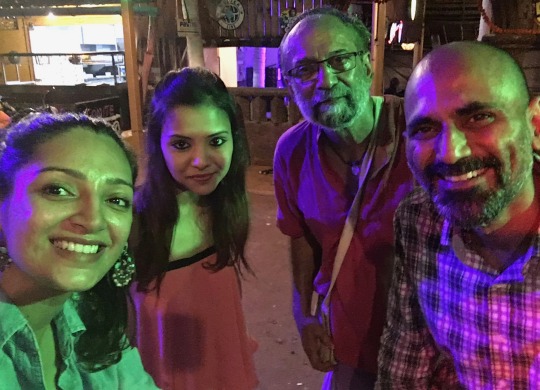
Celebrating the Woodstock 50th anniversary, Guru Bar, Anjuna, Goa, 17 Aug 2019. Pic:Pritesh Tari
When fascism’s dark wing brushes our brow.
When the rape of the earth is the only writ that runs.
And climate change’s chaotic wind hits us in the face.

Celebrating the Woodstock 50th anniversary, Guru Bar, Anjuna, Goa, 17 Aug 2019. Pic:Harsha Prabhu
Revolt! Evolve! Peace Out!
As the song goes: “They got the guns, but we got the numbers.”
1 note
·
View note
Text
Please check my blog on the Woodstock anniversary!
Celebrating Woodstock - Part 1
With the 50th anniversary of the Woodstock festival round the corner, Harsha Prabhu looks back to visiting the US for the 40th anniversary
A Fairy Tale of New York

Parrots for Peace, Ecofest, Central Park, NYC, Oct 2009. Pic: Hans Lovejoy
Blog 1 on the Rainbow Dreaming US tour, covering NYC and Ecofest. Rainbow Dreaming is a photodocumentary on the alternative culture of the rainbow region of NSW, Australia. The curators were invited to set up the exhibit for the Woodstock 40th. See more at http://www.rainbowdreaming.org
Keep reading
#woodstock#woodstockanniversary#ecofest#woodstockmuseum#photography#westfest#nimbin#byronbay#hopi#newyork#sanfrancisco#hippie#beats#rainbowregion#harvestfest#alternativeculture#jack kerouac#nimbinwoodstockconnection#aquariusfestival#hemp#cannabislawreform#elliotlandy
3 notes
·
View notes
Text
Woodstock - The Beat Goes On!
Harsha Prabhu visits San Francisco for Westfest, celebrating the Woodstock 40th anniversary

Westfest, Golden Gate Park, San Francisco, October 2009. Pic: Harsha Prabhu
This is Blog 2 of the Rainbow Dreaming US tour, celebrating the 40th anniversary of Woodstock. Rainbow Dreaming is a photodocumentary on the alternative culture of the rainbow region of NSW, Australia. The curators were invited to set up the exhibit for the Woodstock 40th. See more at http://www.rainbowdreaming.org
Welcome Home!
“Smile, you are in San Francisco”, said the black baggage handler at the airport.
“Welcome home”, said Canyon, a native American activist, giving us all a big hug.
We were at the last planning meeting before Westfest, billed as the 40th anniversary of Woodstock mega free concert in Golden Gate Park. The meet was held in a large warehouse, packed to the rafters with Westfest vendors and supporters. Boots Hughston, artist and impresario and the producer of Westfest, ran the meeting with panache.
The Rainbow Dreaming crew – now down to Hans, Emi, Simeon and myself, our gracious helpers Sayaka, Saya and Rina having left for Tokyo – were given a rousing reception. After the meet, many folks came over to greet us. They plied us with invitations, Westfest merchandise, gifts of ganja, and questions about the exhibit.
Before Woodstock in 1969, way before anything of consequence emerged on the east coast, it was San Francisco that was the spiritual and temporal home of the alternative scene in the US. San Francisco, city of St Francis, patron saint of all creatures great and small and the holy land to every hippie who ever dreamt of wearing flowers in their hair.
Falling Waters
Before we plunged into San Francisco and Westfest, we went on a little trip: Yosemite National Park, 250 kms by road from San Fran.
The trip was Emi’s idea. Honesty demands that I admit I was a reluctant passenger. I wanted to hang out in the Haight, not spend seven hours in a hire car on the highway. But the Haight would have to wait. Here was an opportunity to get away from everything – the manufactured world of men and cities. I’m glad that beautiful Emi won me over.

Yosemite National Park, October 2009. Pic: Emi Iizuka
The climb up the Sierra Nevada and down into the Yosemite valley is stunningly spectacular. Forests of oak and pine, opening out into vistas of glaciated grandeur: vast cathedrals of granite, 2400ft waterfalls, towering spurs and cliff faces, altars fit for giants.
This was the great American photographer Ansel Adams’ playground. Adams first came to Yosemite as a 14 year old with a Box Brownie. He was to spend three decades living, working and photographing the place. He spoke of “the primal song of the wilderness—the whisper of silver winds in the lonely forest–the hollow chant of falling waters.” Adam’s photographs of the Yosemite landscape are iconic images that helped create the idea of wilderness as something worth “saving” in the popular imagination. His photos were used in campaigns by the Sierra Club.

Yosemite National Park, October 2009. Pic: Emi Iizuka
Nothing could save the Ahwahnee, the original inhabitants. They fell victim to the California gold rush and the state militia in the 1850s. Their broken plinths and abandoned hearths speak of a desolation beyond words. The sunset dyed the canyon deep red, then dark crimson. The lights of climbers bivouacked on the cliff face for the night flickered in the gathering dark as we left the valley.
Hippie Hill

Human Be-In, Golden Gate Park, San Francisco, 1967. Source: Web. Photographer unknown
From the Trips Festival, to the Human Be In, to the Summer of Love in 1967, San Fran was where it was all happening. And Haight-Ashbury, a genteel, seedy, low rent neighbourhood on the edge of Golden Gate Park, was, for a short time in that golden, paisley and psychedelic-hued year, the counter culture capital of the world.

Human Be-In, Golden Gate Park, San Francisco, Jan 1967. Source: Web Photographer unknown
Haight-Ashbury today resembles a counter culture tourist arcade, peppered with boutiques and headshops selling all manner of things hippie. It also boasts two excellent bookshops, a generous music store and restaurants with character.
Paul, owner of Land of the Sun, a gift shop with a penchant for hippie paraphernalia, had been in the Haight in the golden age. “I was there before, during and after. I remember $2 concerts with the Dead, Hendrix, Santana, that went on till 2am; Janis driving up and down the strip in her Porsche. The Dead were next door at 710 Ashbury. I haven’t been to a concert since Jerry Garcia died in 1995.”
“That was then. But the Haight still has a spark. The community has managed to block certain kinds of development, like chain stores from moving in. There’s resistance to the Haight becoming like any other suburb. Sure, the Haight is an echo of what it used to be, but it’s an echo worth listening to. The Haight is unique, it’s a peace bracelet.”

Summer of Love poster. Source: Web. Artist unknown
Mark, a more recent resident, agreed. “Despite all the changes, the energy is still there. I remember going to a Phish concert recently. Looking at all the kids, I could have been at a Dead concert in the seventies. There are these tendrils of influence from that time and the Dead have a lot to answer for”, he said, smiling. “Everything’s still the same, except our hair.”
Boutiques and op shops were doing a roaring trade in wigs of every description and outlandish costumes in a pre Halloween shopping frenzy. Teenagers in Marilyn Manson outfits flashed us the peace sign as Hans and I walked towards Hippie Hill.
Encouraging the illusion of a wormhole through time, Hippie Hill is approached through a dark tunnel. Psychedelic art with paintings of mushrooms lined the path. A pair of boots mysteriously sits near the entrance. A hooded figure whispers: “Would the dudes like to sample some Blueberry?”
We sat on the hill under tall trees. Kids played soccer in the oval at our feet. A large, white peace symbol in splattered enamel, Jackson Pollock style, marked the centre of forking paths. Small groups of people, mostly young, dotted the hillside, some playing guitars, singing and passing joints. In the marmalade evening light they looked like stragglers from an enchanted army.
Westfest

Westfest, Golden Gate Park, San Francisco, October 2009. Pic: Emi Iizuka
It looked like all the foot soldiers in the armies of peace, love and enchantment, and their camp followers, had assembled for Westfest, at Speedway Meadows, Golden Gate Park, on Sunday 25 October.

Native American elders, Zen Buddhist priests, musicians for peace, the butterfly folk, the rainbow family of love and light, aging hipsters and young ferals, the Hells Angels and the Hare Krishnas, Guitars Not Guns and Grannies for Medical Marijuana, flaunting their glad rags, flying the flag, flashing the peace sign, getting high on the herb, the vibe, the roar of the music from three stages and the brilliant sunshine.

Westfest, Golden Gate Park, San Francisco, October 2009. Pic: Emi Iizuka
Every surviving rock and roll star from the sixties and seventies (and their dog) seemed to be there. Ray Manzarek from The Doors, Paul Kantner from Jefferson Airplane, Denny Lane from The Moody Blues, Country Joe McDonald, plus the original cast from Hair. Some old timers would have had flashbacks and it wouldn’t have been the acid!

Westfest, Golden Gate Park, San Francisco, October 2009. Pic:Emi Iizuka
And the order of the day, proclaimed by speaker after speaker, was the same: make love, not war. It was the favourite sixties mantra all over again! “Are we proud to be hippies”, the MC would yell and the crowd, estimated at around 100,000, would respond with a jubilant roar.

Westfest, Golden Gate Park, San Francisco, October 2009. Pic:Harsha Prabhu
Westfest was the culmination of the Rainbow Dreaming US tour. We had been assigned a 40ft diameter tipi to set up the Rainbow Dreaming exhibit. At the last minute the deal fell through. Douglas Kolberg, the producer of the Greenzone at Westfest, pointed to a grove of trees and said: “Can you do something with these.”

Westfest, Golden Gate Park, San Francisco, October 2009. Pic:Harsha Prabhu
We could. We had Emi and Sim, our two agile helpers, who climbed up the trees and set up a harness using wire and rope to hang the exhibit. The spot was right in the middle of the vast concourse between the two main stages, so hundreds of punters got to see the exhibit.

Rainbow Dreaming at Westfest, Golden Gate Park, San Francisco, October 2009. Pic: Harsha Prabhu
White Buffalo
Canyon, the native American activist who had welcomed us with open arms at the Westfest planning meet, was one of the last visitors at the Rainbow Dreaming exhibit. He recounted for us the White Buffalo legend.
Two brothers were out hunting for buffalo. They followed the trail for days. Finally, they spotted the herd. They were excited to see one of the buffaloes was white. To their amazement, the white buffalo turned into a beautiful woman.
One of the brothers would have favour with her. He was burned to ashes. The other brother bowed before her. That winter, she took him to the lodge, taught him the prayers, taught him many things. In spring, she turned back into a white buffalo. She said: “I will feed you, now and in the hard times to come. You will use me for your ceremonies. Remember me and I will be with you always.”
Across time and the blood-dimmed tide of history the White Buffalo legend came alive in Canyon’s retelling. We were all yearning for a new way to relate to the earth, to women, to ourselves. The legend seemed to provide vital clues to our renewal as a civilisation.
There were tears in his eyes as he finished the story. He said: “Remember, inside you is the centre of the universe. And the centre is love.”
The Beat Goes On
My last port of call in San Fran was North Beach, the hangout of the Beats.
The Beats were the precursors of the hippies. Like a Russian icebreaker on speed, the Beats cut through the frozen tundra of smugness and coldwar hysteria of 50s America. Beat literature and Beat attitude swept across the globe like a meteor, scattering flames and sparks that ignited minds and hearts. As a teenager growing up in the seventies in faraway Mumbai I avidly devoured the beat writers. Kerouac, Ginsberg, Corso, Burroughs were some of my early heroes.
While the Beats were more into booze and benzedrine, as opposed to the psychedelic reveries of the hippies, they laid the groundwork for the hippie movement. Their Rimbaudean manifesto of excess as the path to satori, flirtation with eastern philosophies, and eclectic approach to sexual liberation was the seedbed that sprouted the summer of love.

Jack Kerouac Alley, San Francisco. Source: Web
“Poetry is the shadow cast by our streetlight imaginations”, wrote Lawrence Ferlinghetti, Beat poet and founder of City Lights, the famous publishing house. City Lights still stands, along with Vesuvio, the Beat watering hole. Alongside runs Jack Kerouac Alley, with quotes from various Beat writers cast in stone in English and poems by Li Po and Confucius in Chinese. Chinatown is next door.
Across the street is the Beat Museum. I spent that last afternoon surrounded by Beat memorabilia, including Kerouac’s typewriter, the signed, annotated copy of Ginsberg’s ‘Howl’ and the voices of my youth.
Some of those voices sound strangely prescient. Here is Ken Kesey, author of ‘One Flew Over the Cuckoo’s Nest’, friend of the Hells Angels and the Grateful Dead, Merry Prankster and veteran of many an Acid Test, on America’s ‘civilising mission’ in another war. “You can’t bomb for a humane reason...”
“I see the Beat Generation as an enlightening movement,” said Beat Museum founder Jerry Cimino. “Because they followed their dreams they changed the world.”
But I’ll let the maddest Beat of them all have the last word: “All human beings are also dream beings. Dreaming ties all mankind together.” Jack Kerouac, Book of Dreams.
by Harsha Prabhu
This is Part 2 of the Rainbow Dreaming US tour blog.

Westfest, Golden Gate Park, San Francisco, October 2009. Pic:Harsha Prabhu
NOTE:
While the words and sentiments in the blogs are my own, this project has been a community cultural initiative, helped along by many hands, hearts and minds. Many thanks are due. First up, Benny Zable, Shelli Lipton & Nathan Koening for setting up the Nimbin Woodstock Connection and the sister village link between the two communities. I would like to acknowledge the help and guidance offered by the Rainbow Dreaming crew – Benny Zable, Hans Lovejoy, Saya Minami, Sayaka Nakao, Rina Terasaki, Emi Iizuka & Simeon Michaels – on this amazing journey to the US.

Emi Iizuka at Westfest, Golden Gate Park, San Francisco, October 2009. Pic:Harsha Prabhu
Thanks to our hosts in the US, including Traci Mann & Nanci Callahan in NYC; Rob Robinson at Harvestfest; Shelli Lipton & Nathan Koenig at Woodstock Museum; and Douglas Kolberg & Boots Hughston at Westfest. Thanks to our principal sponsor Happy High Herbs and our media sponsors Byron Shire Echo & Bay FM. Thanks to all those who donated to the community chest to make this project possible, including all the artist and performers from the rainbow region who helped raise funds for the US tour. And a big thank you to all the freaky people of the rainbow region, who are the inspiration for this project. And the writers and photographers who so generously donated their work. This project was auspiced by Byron Community & Cultural Centre, assisted by Lismore Regional Gallery and supported by Byron Neighbourhood Resource Centre and Mullumbimby & District Neighbourhood Centre. Curated & produced by Harsha Prabhu & Graeme Batterbury for the Rainbow Collective. More on Rainbow Dreaming, including how to get a copy of the book, at: www.rainbowdreaming.org
#woodstock#sanfrancisco#goldengatepark#summeroflove#yosemite#haightashbury#beats#nimbin#byronbay#westfest#humanbein#photography#photodocumentary#woodstockanniversary#beatmuseum#citylights#jack kerouac#whitebuffalo
0 notes
Text
Celebrating Woodstock - Part 1
With the 50th anniversary of the Woodstock festival round the corner, Harsha Prabhu looks back to visiting the US for the 40th anniversary
A Fairy Tale of New York

Parrots for Peace, Ecofest, Central Park, NYC, Oct 2009. Pic: Hans Lovejoy
Blog 1 on the Rainbow Dreaming US tour, covering NYC and Ecofest. Rainbow Dreaming is a photodocumentary on the alternative culture of the rainbow region of NSW, Australia. The curators were invited to set up the exhibit for the Woodstock 40th. See more at http://www.rainbowdreaming.org
Which Woodstock?
“Don’t even bother about coming to Woodstock for the festival in August,” said Nathan Koening, our host at the Woodstock Museum. “It’s mostly expensive hype. Come in October, when the weather is better and there will be more Woodstock-related events to celebrate the Woodstock legacy. And you can set up the Rainbow Dreaming exhibit.”
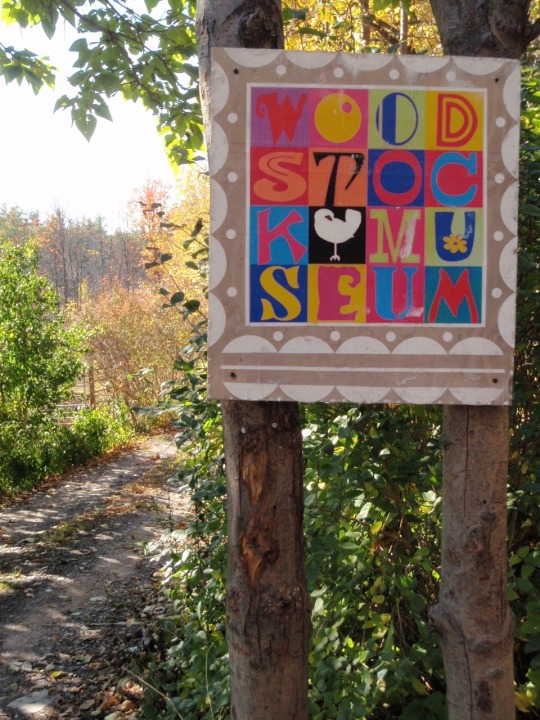
Woodstock Museum, Saugerties, NY, October 2009. Pic: Emi Iizuka
The Woodstock Museum were partners in setting up the historic Nimbin-Woodstock Connection in the mid-nineties, a rainbow bridge linking the alternative communities of Nimbin in north eastern New South Wales, Australia, with the whole hippie tradition of Woodstock. We had sealed the relationship by sending the Woodstock Museum an earlier exhibit from Nimbin, called Some Children of the Dream.
It’s now some fifteen years down the track. Walking down the main strip in Byron Bay I spy Hans Lovejoy sitting in a cafe, sipping on a latte. Hans, musician and journalist for the Byron Shire Echo, was in-between assignments.
“Fancy a trip to Woodstock?” I asked him.
“Which Woodstock?” he asked, undoubtedly knowing there were many: Woodstock, the town; the original Woodstock festival in 1969, which was held some 100 kms away; and the many, commemorative events down the years, held wherever the required permits could be obtained and the producers and sponsors lined up with the dollars.
“Not the festival,” I replied, “It’s a celebration of the Woodstock legacy.”
“Why not,” he said.
Lords of the Material Universe
The first signs were auspicious.
At Brisbane airport, waiting to catch the flight out to LA, we bumped into Elizabeth Thorpe and Debbie Lee. Elizabeth and her partner Ray, proprietors of Happy High Herbs, were the principal sponsors of Rainbow Dreaming and Lee, artist and designer, is an old connection from Nimbin. Elizabeth and Lee were headed for USA to open Happy High’s first US store, in Arizona. And Hans and myself were headed for New York, bringing with us the stories and pictures of life in the rainbow region.
From the plane, the New York nightscape glowed and flickered like some gigantic circuit board. “The lords of the material universe have nice real estate here”, said Hans. Towers of ivory, streets of gold. Would the lords be kind to us? Would they let me in, with my Indian passport?
At immigration, there was a blip: Had my passport ever been stolen? Why was it registered as Australian? The question in my head went something like: So this is what it feels to be at the mercy of dodgy databanks and the mood of the assessment officer. But it turned out ok. After a few questions, Officer Pena waived me through.
Did I have anything to declare, the customs man asked? Don’t touch my bag if you please, I have a haversack full of rainbow dreams, I mused to myself.
At the airport, the smiling face of Benny Zable, waiving a rainbow flag, greeted us. Benny, Nimbin’s ambassador to Woodstock, was the kingpin in the rainbow bridge to Woodstock and beyond. Benny had arranged for us to stay in Brooklyn, at the studio of Traci Mann, a New York tap dancer.
Disoriented by jet lag, Hans had left his laptop on the airport bus. That first night, with the El roaring past our window, we fell into a troubled sleep, woken by the clatter of the El and the cries of children at the daycare centre below.
Through a Glass
Our first pilgrimage in New York was to the Yippie Museum in Greenwich Village. The Village was the bohemian hangout par excellence in the sixties. It still has a funky, if gentrified, look. Jazz bars and restaurants dot the streets.
The Yippie Museum resembles the Nimbin Museum, with a stage for performances. One night, we caught some fine performance poetry. It’s the headquarters of New York’s hemp legalization campaign. They knew about Nimbin. They were also involved with a global linkup of cities for 2010.
1st Oct saw the launch of Mark Roselle’s book “Tree Spiker”. Mark Roselle is the founder of Rainforest Action Network. He’s also the man who infiltrated a Nevada test site. The day was also Benny’s birthday, Benny, an agent provocateur with his rainbow flags. The Yippie Museum was a happening place, true to its name of promoting green(sic) issues through direct action.
It took us a while to work out what ‘uptown’ and ‘downtown’ meant in the subway, but we had worked it out by the time we left New York!
Hans slipped out one night for a dose of jazz; the girls went on a harbour cruise; Benny was beavering away at the Ecofest office. My jet lag meant that I saw the city as if through a glass darkly. One image remains: a black, immaculately dressed saxplayer, doing “In a Sentimantl Mood” in the subway at 50th St.
Ecofest

Ecofest, Central Park, NYC, Oct 2009. Pic: Harsha Prabhu
The Ecofest office, off Broadway, was a hive of activity, presided over by Nanci Callahan, queen bee and director/producer of New York’s signature ecological fair, now in it’s 21st year.
We walked to Central Park to check out the site for this year’s Ecofest, passing Strawberry Fields and ‘Imagine’, the mosaic tribute to John Lennon. On park benches huddled New York’s homeless, shrouded in grey, under the shadows of the tall towers ringing the park. The Dakota apartments where Lennon had been shot were across the street. “Yoko Ono pays for the maintenance of this section of the park and the homeless are permitted to sleep here,” Benny explained. I thought of our homeless in Byron, chased from bus shelters, their beach humpies a mark for rangers. In this instance, New York seemed to have a heart.
Sunday 4th Oct was a fine day. The Ecofest site began to fill up with vedors and exhibitors, including the latest hybrid cars from Toyota and Ford.
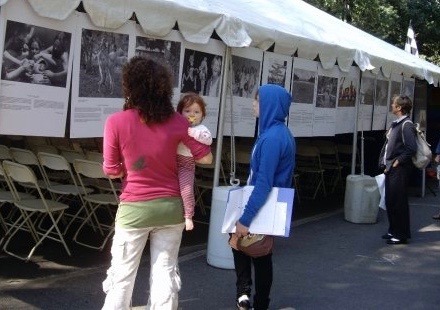
Rainbow Dreaming at Ecofest, Central Park, NYC, Oct 2009. Pic: Harsha Prabhu
We had been assigned the outer wall of the conference tent to set up the Rainbow Dreaming exhibit. Space restrictions meant only half the exhibit could be accommodated. We punched holes into the exhibition panels and strung them out on twine like washing on a line. It worked! Sayaka Nakao, Rina Terasaki and Saya Minami, our Japanese friends from Byron Bay, who had flown in the previous day via Tokyo to help with the exhibition tour, assisted us in this improvisatory task. Ever enthusiastic, our petite helpers were worth their weight in gold. Hans and I would have struggled to manage the show on our own.
Over 25,000 visitors streamed through Ecofest that day and, as we were positioned at the entrance, many of these stopped by to check the exhibit. Among these was Nirmala, Gina Lakosta’s daughter, who was in New York to perform a burlesque show, under the stage name La Viola Vixen. Another was a couple from Goonengerry, amazed to stumble upon a slice of life from the rainbow region in the heart of New York.
Tap dancers, including the amazing Mabel Lee, Traci Manns’s former teacher, all of 80; soul singers; stiletto heeled models strutting eco fashions; Rick Ulfik from We the World, the global peace network; Parrots for Peace from the Amazon rainforest; ending with a sing along with the legendary Pete Seeger, 90 years old and still singing his peace and environmental anthems.
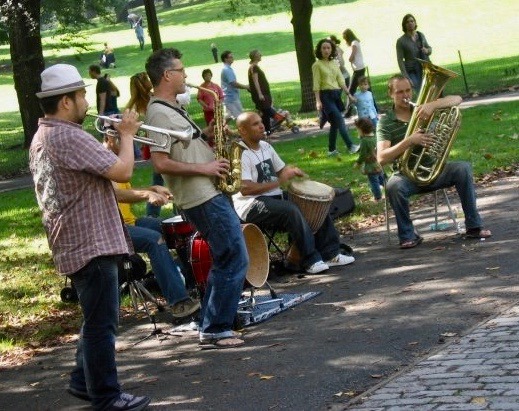
Jam session, Central Park, NYC, Oct 2009. Pic: Harsha Prabhu
The sun shone down on Benny Zable’s rainbow flags; children fed ducks in the pond; whole families happily picnicked under the trees; frisbees flew in the air. Catching the last of the sunset, the tall towers seemed to shower us with riches and green fields became fields of gold.
The evening ended with drumming. Three drum circles – Cuban, Haitian and African – rang out in the Park. The moon was full and so were our hearts.
Postscript: Hans’ laptop, lost on our first night, was returned to him by the New York City Transport Authority on our last morning in New York, in a fairy tale ending to our stay in the Big Apple!
Van Gets Ripped, or The Long Sleep of Unreason
Blog 2 on the Rainbow Dreaming US tour, taking in New York’s 13th Harvest Festival & Freedom Rally, Hancock, NY; and Woodstock Museum, Saugerties, NY.

Ma & Pa Woodstock, NY Harvest Fest & Freedom Rally, Camp Minglewood, Hancock, October 2009. Pic: Harsha Prabhu
New York Harvest Fest & Freedom Rally
Marijuana legalisation activists and their supporters on the East coast were to meet at Camp Minglewood in the Catskills, a couple of hours north of New York, for the Harvest Festival & Freedom Rally, on 9 Oct.
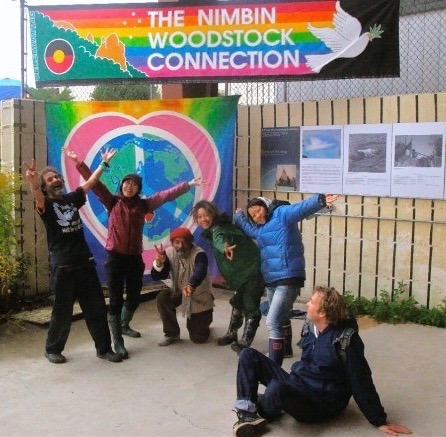
Rainbow Dreaming crew at New York Harvest Fest & Freedom Rally, October 2009
It was an opportunity too good to be missed. Our hosts from the Woodstock Museum, Shelli Lipton and Nathan Koenig, had booked us a spot at the Festival. They had also booked us into a bunkhouse, with 10 bunk beds. By now we had mushroomed to a party of 10.
It wasn’t pot, but potties that preoccupied us the three days we were there. The toilets were blocked. Much time and energy was spent agonizing over the situation and negotiating the portaloos well before the happy horde that had descended on the Camp trashed them every morning.
Harvest Fest, the child of Hemp activist and performance poet Rob Robinson, was now in its thirteenth year. The legal situation with pot in the US is complex and confusing. Some states (California) allow the medical use of marijuana. Others will bust you for possessing rolling papers. The talk at the Camp was all about the bust of a long-time hemp activist, who had been caught with a whole lot of pot that he was bringing to the festival. Regardless, the pot was plentiful.

Camp Minglewood, Hancock, October 2009. Pic: Harsha Prabhu
From pot to politics. I met Kurt Shotko, a member of the Greens party. Kurt was of the opinion that the Republicans and Democrats were cut from the same cloth, manufactured by big business. “Look at what Obama’s doing in Afghanistan. He’s sending more Americans to die there. We need an alternative to the main players. We’ve got to wake up to the reality that the American dream has been a nightmare for a lot of Americans and for the rest of the world, especially in Iraq and Afghanistan. We have been asleep for too long. We need a revival of common sense. Only a massive program of self education is going to do it.”
Then he quoted from the Populist Program, published in 1892: “They propose to sacrifice our homes, lives and children on the altar of mammon; to destroy the multitude in order to secure corruption funds for the millionaires.”
1892! The sleep of unreason had been a long one.
But Kurt was hopeful of the next generation. That’s why he set up camp at festivals across the US. And that’s partly why we were there too.

Benny Zable in front of archival pic from Rainbow Dreaming, NY Harvest Fest & Freedom Rally, Camp Minglewood, Hancock, October 2009. Pic: Harsha Prabhu
The Rainbow Dreaming exhibit was attached to a wall in the main music hall. Thus many, mostly young, punters got to see the exhibit. This was where The Wailers played on Saturday. I caught the Wailers when they played in Byron and I’m happy to report that they are still wailing away.
But what struck me most about the music at Harvest Fest was the pervasive influence of the Grateful Dead, the legendary sixties psychedelic band from San Francisco. From Cabinet, an established US indi band that played the main stage, to camp fire songs at 4 am, the Dead were everywhere, on so many t shirts and stickers, in so many riffs and improvisatory moments, as a psychedelic glint in so many eyes.

George Clinton & Funkedelic, NY Harvest Fest & Freedom Rally, Camp Minglewood, Hancock, October 2009. Pic: Harsha Prabhu
I spoke with Jane, an artist from New York, who had a stall selling Dead memorabilia. She had grown up in San Francisco and was still a Deadhead. Her eyes misted when she spoke of Jerry Garcia: “You could see so much love pouring out of him. It was a love affair that lasted and lasted and it’s still going strong even when he’s gone.”
Minglewood Moment: across from the festival site, two lovers sit on the steps of a boat ramp. The dying sun paints purple tints on the tops of the maple and elm; waterfowl break the surface of the lake. A band is playing the Dead’s “China Cat Sunflower.”
Woodstock: The Town that Time Forgot
In Rip Van Winkle, Washington Irving’s story, a man who wanders off into the Catskill Mountains, meets some rather strange companions who serve up a suspiciously heady brew, and falls asleep under a tree. When he wakes up, he finds that some 20 years have gone by and his world has changed.
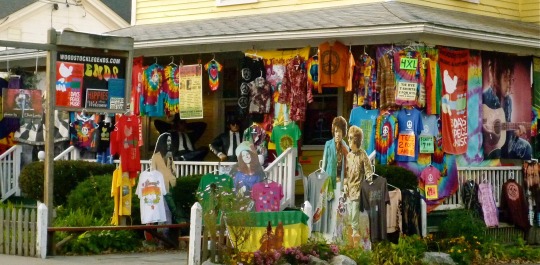
Woodstoock, October 2009. Pic: Harsha Prabhu
The town of Catskill is 30 minutes away from Woodstock. Some 40 years have gone by after the infamous Woodstock festival of 1969. And the world has changed since those heady days. But walking around Woodstock, the town that gave a name to the festival, (which happened in the neighbouring town of Bethel, some 100 kms away), you could be forgiven for believing that it’s still in the thrall of those halcyon days of hippiedom.
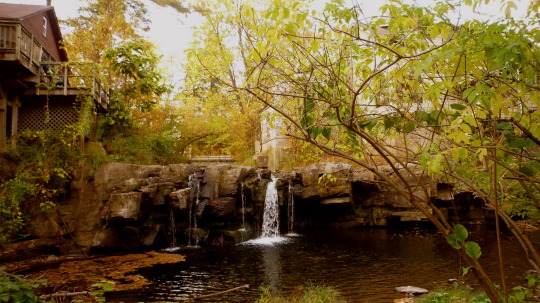
Woodstoock, October 2009. Pic: Emi iizuka
Our first port of call was the Woodstock Town Board meeting that night. Benny Zable, Nimbin’s ambassador to Woodstock, presented letters from Nimbin and the crew made a presentation on the Rainbow Dreaming exhibit and its relevance to the whole Woodstock legacy.
The meet was dominated by a spirited discussion over rezoning issues, something very familiar to us on the north coast. Would Woodstock go the way of other small towns and be besieged by rampant development, or would it stay true to its alternative legacy?
That night we also visited the Bearsville Cultural Centre (set up by Albert Grossman, one-time manager of Bob Dylan, Janis Joplin and The Band) and Alchemia Café to catch some live music, including a spirited set by Adam, a young musician we had met at the Byron market drum circle!
Guided around by Benny, on our very first day in Woodstock, we met some representatives of Woodstock’s hippie past: Jogger John, the local village savant, who used to jog everywhere, but, due to his advanced age is now is on a bike; Day A, the village barber, who runs a soup kitchen for the Rainbow Family in town; Grandpa and Grandma Woodstock, an elderly couple, dressed the part, almost town mascots. Woodstock itself is full of funky cafes and art galleries. Turn a corner and spy a Zen garden, complete with waterfall and pergola.

Peace Pole, Woodstock, October 2009. Pic: Emi Iizuka
In the centre of Woodstock town is the village green and the peace pole, with peace messages in several languages. We bumped into Fr John, a priest and peace activist. When he heard that two of our crew, Sayaka Nakao and Rina Terasaki, were from Tokyo, he beamed at them and said: “ Let’s set up a peace link between Woodstock and Tokyo. All it takes is five people. Five is the magic number. Can you find five friends in Tokyo who may be interested?”

Hippie Church, Woodstock, October 2009. Pic: Harsha Prabhu
Fr John also runs the Hippie Church, on the hill overlooking Woodstock. This was the very church where Bob Dylan was rumoured to have married the love of his life, Sarah, his sad eyed lady of the lowlands. The church wears the patina of age, its icons fading in the dim, dank light streaming through stained glass windows.

Path to Buddhist monastery, Woodstock, October 2009. Pic: Harsha Prabhu
In stark contrast is the Buddhist monastery next door. Set up in 1975, the monastery is linked to the 10th century Tibetan Kagyu lineage. Its halls are huge and lushly decorated with tankas, its massive Buddha is gold-painted, its prayer lamps cast a beatific glow on meditating monks and visitors; its gift shop bulges with merchandise, all a tribute to Buddhism’s growing influence in the new world.
Prophesy
The next morning, my very first snowflakes, fine and feathery.
It was too cold to venture out. Emi Iizuka and Simeon Michaels, both from Byron, had joined us in Woodstock. We were toasty warm at the Woodstock Museum, hosted by Shelli and Nathan.
Under the tutelage of Shelli, the sacred Indian corn was brought out and inspected. Purple, yellow, orange, red and black, this was authentic Hopi corn. The girls played with the corn silk, good for medicinal tea and dress ups, fake moustaches and beards. They were transformed into imaginary characters, magical beings, the warrior princesses of Genghis Khan, dressed as men to pass unnoticed amidst the ripening corn. Shelli makes beautiful corn necklaces, a craft she learnt from Rainbow Weaver, a Mohawk Clan Mother.

Padmasambhava, Buddhist monastery, Woodstock, October 2009. Pic: Emi Iizuka
Nathan spoke about the connection between the Hopi and the Tibetans. “Padmasambhava, the founder of Tibetan Buddhism, said: When the iron bird flies and the horses run on wheels the Tibetans will be scattered over the face of the earth and the dharma will come to the land of the red man.”
Nathan went on: “The Hopi’s felt that this might have something to do with the dharma coming to the US. They have prophesies too. After the swastika and the sun, there would be another force, symbolized by the colour red. This force will wear a red cloak or red cap. Spiritual wisdom will come from the East. This spirituality must spread. If that does not take root, others with the red symbol will invade from the West and crawl over the land in one day. The Hopis think this could be the ‘red’ Chinese.”
“When the Tibetan Karmapa visited Hopiland in 1974, he said: We must have know each other before; your features, ceremonies and way of life are similar to our own. When we bought Hopis to the monastery in Woodstock in 1979, the two cultures again recognized each other, and the Hopis said that the Tibetans may very well be the long lost brother who left them at the beginning of time and went to the other side of the earth to balance the earth spiritually.” Said Shelli: “When the shit hits the fan, we won’t survive unless we cooperate with each other. That’s also what the Hopi prophecies speak of. The Hopis are known as the ‘peaceful ones’.”
While we spoke of prophecies, outside, in the gathering gloom, Tiago Guimaraes, a Brazilian artist, was busy carving out a statue of a man with a guitar, the quintessential hippie hitchhiker, his hand raised, his fingers flashing the peace sign.
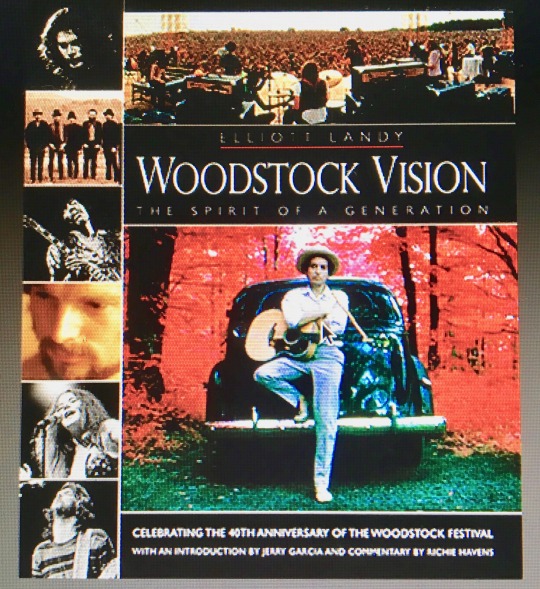
Elliot Landy’s book on Woodstock
The Rainbow Dreaming opening at the Woodstock Museum on Sat 17 Oct was a modest yet sweet affair: local musos were in attendance and we joined the members of the Woodstock drum circle in a bongothon.
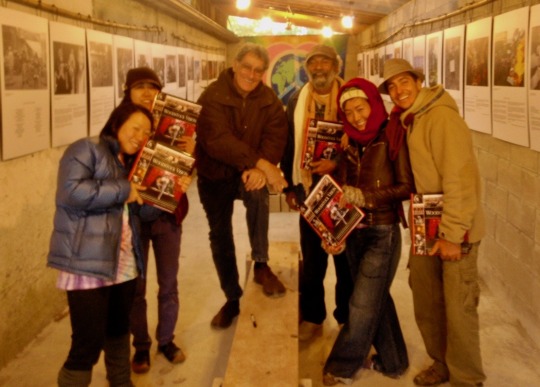
Rainbow Dreaming crew with Elliot Landy, Woodstock Museum, October 2009. Pic: Hans Lovejoy
The highlight of the evening was meeting Elliot Landy, the famous Woodstock photographer. Elliot was all praise for the exhibit, gave away signed copies of his book to all the crew and offered to help us find a publisher for a book on the exhibition. (Sadly, I was to leave my copy on the street in San Francisco while moving house.)
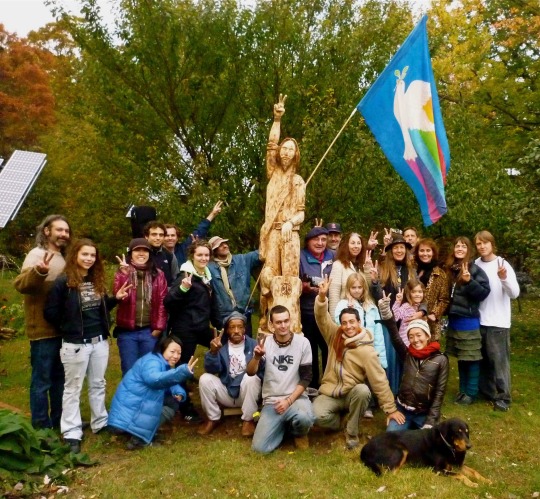
The Last Hippie, Woodstock Museum, October 2009. Pic: Harsha Prabhu
The last act of the day was raising the sculpture of the hippie hitchhiker and placing him on his pedestal: a symbol of Woodstock’s hippie past and a pointer to its uncertain future as a cultural pilgrimage centre.

Woodstock Earth, after the drum circle, October, 2009. Pic: Simeon Michaels
On our last evening in Woodstock, we participated in the Woodstock Earth drum circle. Some 30 drummers were gathered in the backyard at Day A’s house. In summer, the drummers gather at the village green and spill out onto the road. As the sound of the drums rose over the autumn dusk, we were again reminded of how lucky we were with our vibrant culture of communal drumming and dancing in the rainbow region.
Last days in New York: the Bangladeshi cigarette sellers; the African rickshaw pullers in Central Park; the old men and women carting large bundles of recyclable cans and bottles; the man in Times Square offering to sell me a 15 carat gold ring or Obama condoms.
While the crew went shopping and sightseeing I wandered back to Central Park. More than the statue of Liberty, than Ground Zero, than the suicide gulches and canyons of Wall Street, I was drawn to the spot with the Imagine mosaic and tribute to John Lennon. Park benches line the walkway, each with its dedication. I sat there, amidst the touros and derros, as the shadows lengthened.
Then I saw these lines from Dylan Thomas, carved on a park bench: “Though lovers be lost love shall not; And death shall have no dominion.”
Celebrating Woodstock - Part 2 on San Francisco’s Westfest and the Beats to follow. Please check my blog...
by Harsha Prabhu

Rainbow Dreaming crew at Magic Mountain, Woodstock, October 2009
NOTE: An edited version of A Fairy Tale of New York was published in the Byron Shire Echo, October 2009. While the words and sentiments in the blogs are my own, this project has been a community cultural initiative, helped along by many hands, hearts and minds. Many thanks are due.
First up, Benny Zable, Shelli Lipton & Nathan Koening for setting up the Nimbin Woodstock Connection and the sister village link between the two communities. I would like to acknowledge the help and guidance offered by the Rainbow Dreaming crew – Benny Zable, Hans Lovejoy, Saya Minami, Sayaka Nakao, Rina Terasaki, Emi Iizuka & Simeon Michaels – on this amazing journey to the US. Thanks to our hosts in the US, including Traci Mann & Nanci Callahan in NYC; Rob Robinson at Harvestfest; Shelli Lipton & Nathan Koenig at Woodstock Museum; and Douglas Kolberg & Boots Hughston at Westfest. Thanks to our principal sponsor Happy High Herbs and our media sponsors Byron Shire Echo & Bay FM. Thanks to all those who donated to the community chest to make this project possible, including all the artist and performers from the rainbow region who helped raise funds for the US tour. And a big thank you to all the freaky people of the rainbow region, who are the inspiration for this project. And the writers and photographers who so generously donated their work. This project was auspiced by Byron Community & Cultural Centre, assisted by Lismore Regional Gallery and supported by Byron Neighbourhood Resource Centre and Mullumbimby & District Neighbourhood Centre. Rainbow Dreaming was curated & produced by Harsha Prabhu & Graeme Batterbury for the Rainbow Collective. More on Rainbow Dreaming, including how to get a copy of the book, at: www.rainbowdreaming.org
#woodstock#woodstock festival#newyork#woodstockmuseum#nimbin#byronbay#photography#hopi#rainbowregion#padmasambhava#ecofest#cannabislawreform#elliotlandy#hemp#woodstockanniversary
3 notes
·
View notes